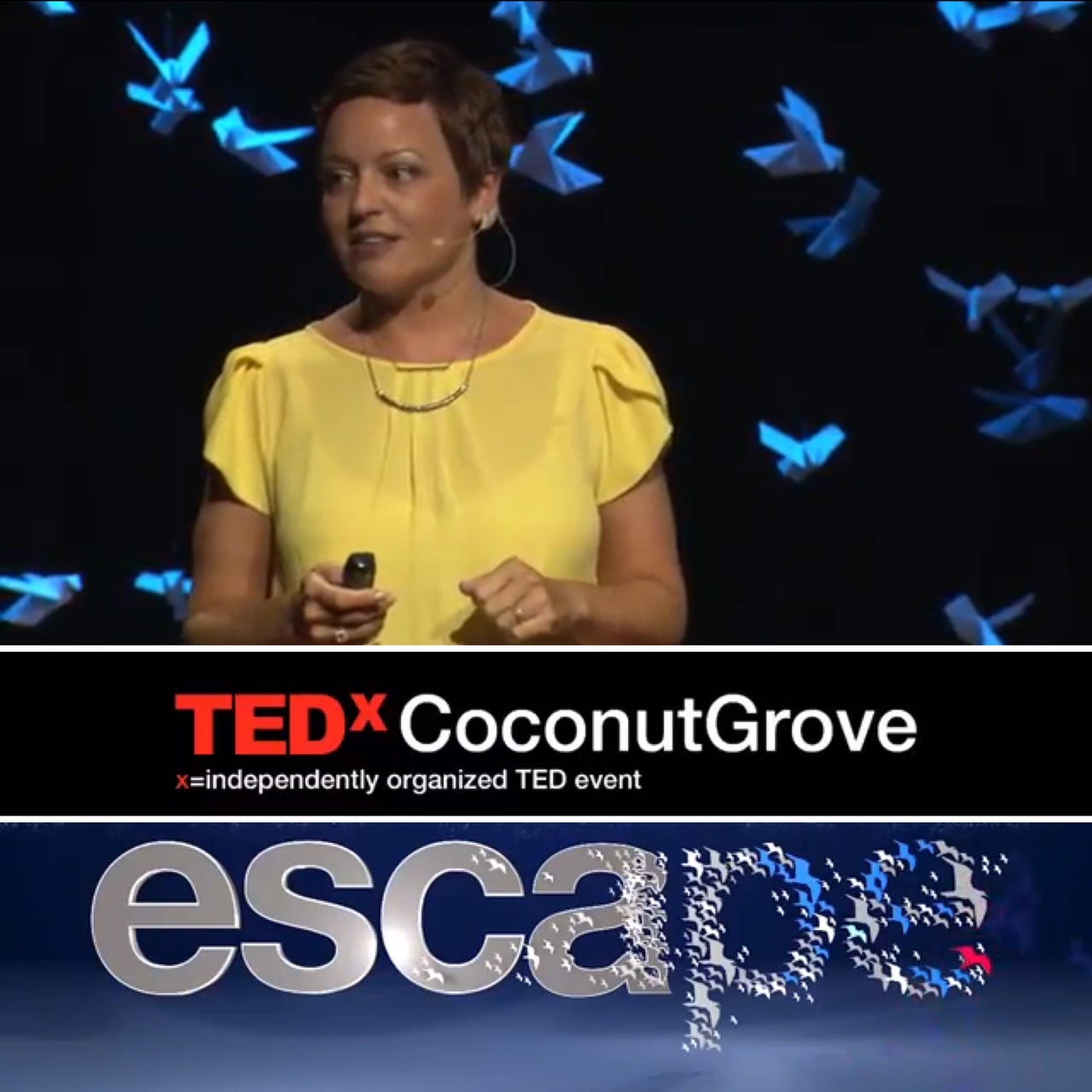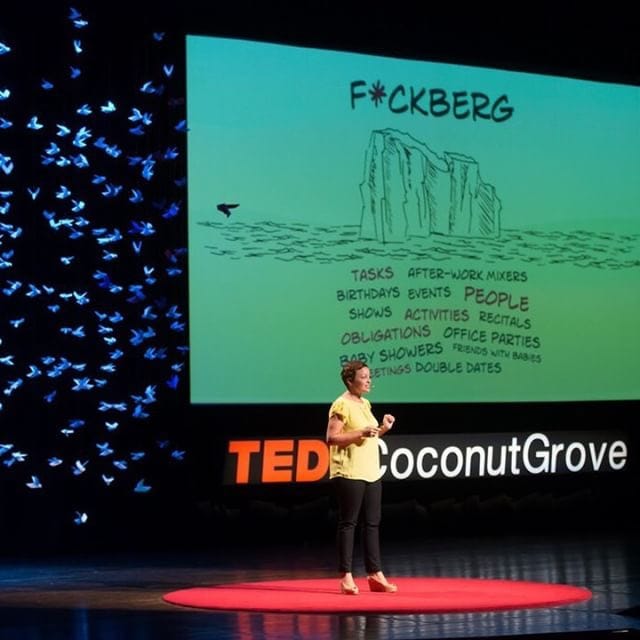5 Tips for Giving a Successful TED Talk
Mine has 10 million views and counting. Here's how I did it!
In 2017 I gave a TEDx Talk called “The Magic of Not Giving a Fuck” and it went on to get 10 million views, WHICH IS WILD. Now I’m sharing five tips on how I got there, for anyone who finds themselves in the same position I did back when the idea of speaking for ten minutes in front of 1,000 strangers was a) purely theoretical and b) moderately terrifying.
(You can watch the video HERE, if you’re so inclined.)
1. Be prepared
When TEDx Coconut Grove reached out to me about speaking at their 5th annual conference, the first thing I did was email Dr.
, a friend and TED alum. I told her that the whole thing made me a little nervous, and she told me the secret was simply to prep my ass off. What she actually said was, “I’m sure you can handle it because you are constitutionally incapable of not doing your best.” (She wasn’t wrong, but still . . . a thousand people???)With her pep talk in my back pocket, I took a deep breath, said yes to TEDx, and embarked upon ten months’ worth of writing, revising, and memorizing — plus collaborating with Nadine Hanafi of We Are Visual on a set of slides, which meant practicing my talk with the slides — and also practicing my talk nude, intoxicated, and in a restaurant that was largely empty except for a handful of bored wait staff.
I’ll let you wonder whether I did all of those at the same time.
2: Don’t reinvent the wheel
The other thing I did after I accepted TEDxCoconutGrove’s invitation was download Chris Anderson’s TED Talks: The Official TED Guide to Public Speaking. Ultimately, it didn’t tell me anything I didn’t already intuitively know, but I think it’s probably very helpful for people who aren’t as used to writing out arguments and/or hogging the conversation at dinner parties.
For me, crafting the talk itself was similar to writing every article or essay I’ve done for places like Marie Claire, Cosmopolitan, Harper’s Bazaar, or here on Substack — and there was no need to get fancy with it. You just have to make an argument, make it compelling, and make it fit a pretty strict word count. In this case, my contact at TEDx advised me that a 1,500-word text would come in around ten minutes spoken, so that’s what I aimed for. Some folks at my conference talked for almost twice as long, and all I can say is, I’m glad I didn’t have to do twice the memorizing, because we would have run out of hot water if I tried to get through a twenty-minute rehearsal in the shower every day.
3: You do you
The gentleman who went on stage before me was a lawyer who spoke about torture in Cuban prisons. And he was appropriately serious, as was a woman whose talk centered on the untimely death of her husband and daughter. In my case (and befitting my “brand”), I wanted my speech to be funny. Your topic and tone should match, and they should also be organic to who you are. A lawyer who goes out there and tries to do stand-up comedy about Fidel Castro is probably going to fall flat.
If you have the opportunity to collaborate on multimedia, this tenet should extend to your slide show. Nadine and I wanted my slides to complement the content and style of the talk, and I think that’s a big part of what made the full presentation so successful. If I’d tried to do ten minutes on “not giving a fuck” with a bunch of complex graphs or inherently un-funny illustrations, the overall effect would have suffered.
Instead, I got my very own “fuckberg” out of the deal.
4: Beta test on humans
In retrospect, I wish I’d practiced in front of even more people. Because although my husband was a patient listener, there’s just no way one person is going to laugh at every joke, every time — especially after three or four run-throughs, let alone forty-seven. Apart from him, a few Spanish-speaking waitresses (I live in the Dominican Republic, so the language barrier is mine, not theirs), and the lizards who live on our terrace (a famously tough crowd), rehearsing was a relatively solitary process.
This meant that I never developed a clear sense of pacing outside of my own performance; it was 9 minutes and 45 seconds, pretty much every time. But on the day-of, the actual talk came in at over twelve. Huh.
I did one rehearsal in the venue the day before the event, but at that point there were only about ten people in the auditorium and none of them were paying customers, so to speak. While I did get a sense of what it felt like to use the microphone and look into the blinding spotlights, I didn’t get much of a laugh track. Once I was up there for the real thing (P.S. DID I MENTION THERE WERE A THOUSAND PEOPLE THERE?!?), I wound up going over my time slot by two full minutes because — whaddaya know? — people laughed. A lot!
And yes, that was lovely, but it was also confusing. When you’ve practiced the same words over and over again in the same order, at the same tempo, for weeks, you can easily get distracted by new reactions, lose the thread (or in my case, get a little too cocky), and mess up in a way you have literally never messed up once in a hundred recitations.
Which is why another big part of giving a successful talk is “being prepared to roll with the punches.”
5: Have a contingency plan (or two)
You’ve written a good speech — by this point many people/lizards have approved its content — and you’ve committed it to memory. Congrats! Maybe you even did some light choreography, plus you’ve got your slide-clicking finger well-trained. Great. But what happens if the mic goes on the fritz? Or if your PowerPoint slides black out? Or you catch a super cute nude patent leather Stuart Weitzman cork wedge sandal in the plush red carpet on stage and fall on your face?
Believe it or not, these were all things I planned for. I rehearsed not only my speech, but what I would do if there was a technical malfunction or a Jennifer Lawrence-y stumble. I’m not kidding. (I’m also not very coordinated.)
Luckily, nothing did go horribly awry, but I definitely had a few tricks up my yellow Juliet cap sleeve, just in case.
So those are my tips for giving a successful TED Talk—or any talk, really. Can I guarantee 10 million views if you follow them? Eh, maybe not, but I can guarantee you won’t look like a Big Dummy on your Big Day, which seems like a pretty solid outcome. Good luck. I’m rooting for you! (And so are the lizards.)
If you liked this post, consider subscribing to No F*cks Given® with Sarah Knight to get more like it straight to your inbox. Paid subscribers hear from me every Monday on topics like goal-setting, motivation, boundaries, anxiety-management, and more—plus access to private discussion threads and other exclusive paid perks!
A bit about me: I spent 15 years as a book editor in NYC before quitting that career to pursue a freelance life (a decision that involved a lot of red wine and a lot of tears). In 2015 I had the idea for my first book, The Life-Changing Magic of Not Giving a Fuck. And people loved it, so I kept writing! Today my sweary self-help series includes Get Your Shit Together, Calm the Fuck Down, Grow the Fuck Up, and more, with 3 million copies in print all over the world. You can also find me on Instagram, where my content skews tropical (in addition to quitting my job, I quit New York entirely and moved to a small fishing village in the Dominican Republic), plus food, cocktails, travel, and cats. So many cats.






